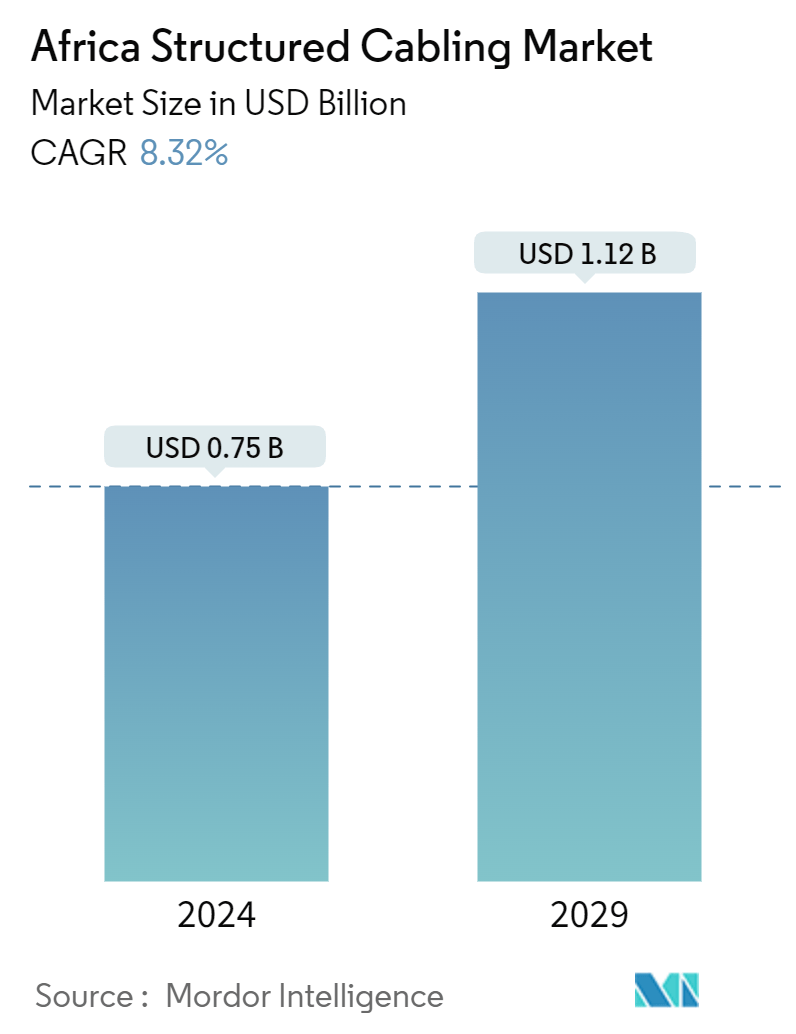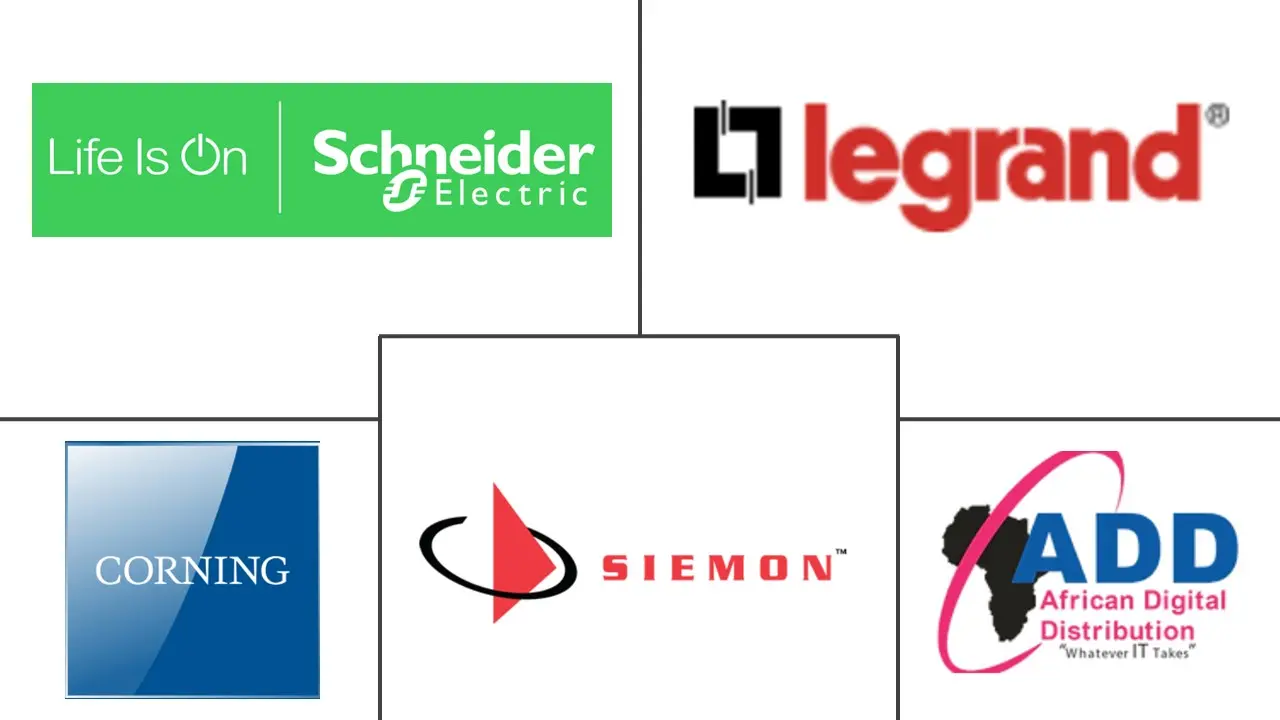Market Size of Africa Structured Cabling Industry

| Study Period | 2019 - 2029 |
| Base Year For Estimation | 2023 |
| Market Size (2024) | USD 0.75 Billion |
| Market Size (2029) | USD 1.12 Billion |
| CAGR (2024 - 2029) | 8.32 % |
| Market Concentration | Low |
Major Players
*Disclaimer: Major Players sorted in no particular order |
Africa Structured Cabling Market Analysis
The Africa Structured Cabling Market size is estimated at USD 0.75 billion in 2024, and is expected to reach USD 1.12 billion by 2029, growing at a CAGR of 8.32% during the forecast period (2024-2029).
- The African structured cabling market is transitioning toward growth, propelled by increased investments in communication infrastructure and a trend toward data center convergence. Moreover, a surging demand for high-speed connectivity devices and systems bolsters market expansion.
- Major subsea cable projects, 2Africa and Equiano, are nearing completion. Their launch is anticipated to double Africa's internet capacity, paving the way for a swift adoption of 5G technology. Governments and telecom giants are channeling significant investments into 5G infrastructure, providing benefits like high speeds, reduced latency, and enhanced coverage, spanning both urban and rural landscapes. Submarine cable systems, like 2Africa, are planned to revolutionize African connectivity and initiatives like diversifying communications between APAC and Europe.
- As network coverage becomes a critical focus, cross-border collaborations are increasingly vital. Governments are teaming up with telecom operators, tech firms, and development agencies. This collaboration not only drives infrastructure projects but also facilitates knowledge exchange, ultimately leading to a more interconnected continent. As per the data by International Finance Corporation and Google, Africa's internet economy will grow the continent's GDP by USD 180 billion by 2025. This provides a critical opportunity for a strong digital infrastructure to support the growth of the market.
- Many regions of Africa lack network infrastructure, including reliable power supply and internet connectivity, to facilitate the deployment of data centers and high-speed data networks. The shortage of skilled professionals in data structure cabling technology also hampers the market’s growth.
Africa Structured Cabling Industry Segmentation
The African structured cabling market study tracks the revenue gathered through the sale of cables (copper and fiber) and connectivity solutions (patch cords, jumpers, transceivers, fiber connectors, adaptors, panels, etc.) in the African region.
The African structured cabling market is segmented by type (copper [copper cable and copper connectivity] and fiber [fiber cable (single-mode & multi-mode) and fiber connectivity]), application (LAN and data center), and country (Nigeria, Egypt, South Africa, Algeria, Morocco, Ethiopia, Kenya, Angola, Tanzania, Ghana, and Rest of Africa). The market size and forecasts are provided in value (USD) for all the above segments.
| By Type | ||||
| ||||
|
| By Application | |
| LAN | |
| Data Center |
| By Country | |
| Nigeria | |
| Egypt | |
| South Africa | |
| Algeria | |
| Morocco | |
| Ethiopia | |
| Kenya | |
| Angola | |
| Tanzania | |
| Ghana |
Africa Structured Cabling Market Size Summary
The African structured cabling market is experiencing a transformative phase, driven by significant investments in communication infrastructure and the convergence of data centers. The demand for high-speed connectivity devices and systems is a key factor propelling market growth. Major subsea cable projects, such as 2Africa and Equiano, are set to enhance Africa's internet capacity, facilitating the rapid adoption of 5G technology. This technological advancement is supported by substantial investments from governments and telecom giants, aiming to provide high speeds, reduced latency, and improved coverage across urban and rural areas. Cross-border collaborations among governments, telecom operators, tech firms, and development agencies are crucial in driving infrastructure projects and fostering knowledge exchange, which is essential for a more interconnected continent. Despite challenges like inadequate network infrastructure and a shortage of skilled professionals, the market is poised for expansion, supported by the increasing digital transformation across various sectors.
The fiber segment is anticipated to grow significantly, fueled by the rising demand for high-speed internet access due to digital transformation, e-commerce, cloud services, and online media consumption. The widespread adoption of 5G technology and enhancements in broadband infrastructure are expected to create lucrative opportunities for the structured cabling market. South Africa holds the largest market share, benefiting from substantial investments in telecommunications infrastructure, including fiber optic networks and 5G deployments. Government initiatives to improve digital connectivity and promote ICT adoption have further bolstered the market, particularly in sectors like education, healthcare, and government. The market is characterized by fragmentation, with key players such as Africa Digital Distributors Limited, Corning Incorporated, Legrand Group, Schneider Electric SE, and The Siemon Company driving advancements. Recent developments, including the expansion of Siemon's UltraMAXTM copper connectivity system and strategic alliances like those between Angola Cables and Camtel, highlight ongoing efforts to enhance connectivity and service quality across the continent.
Africa Structured Cabling Market Size - Table of Contents
-
1. MARKET INSIGHTS
-
1.1 Market Overview
-
1.2 Industry Value Chain
-
1.3 Analysis of Micro-economic Scenarios (Recession, Russia-Ukraine Crisis, etc.)
-
-
2. MARKET SEGMENTATION
-
2.1 By Type
-
2.1.1 Copper
-
2.1.1.1 Copper Cable
-
2.1.1.2 Copper Connectivity
-
-
2.1.2 Fiber
-
2.1.2.1 Fiber Cable (Single-mode & Multi-mode)
-
2.1.2.2 Fiber Connectivity
-
-
-
2.2 By Application
-
2.2.1 LAN
-
2.2.2 Data Center
-
-
2.3 By Country
-
2.3.1 Nigeria
-
2.3.2 Egypt
-
2.3.3 South Africa
-
2.3.4 Algeria
-
2.3.5 Morocco
-
2.3.6 Ethiopia
-
2.3.7 Kenya
-
2.3.8 Angola
-
2.3.9 Tanzania
-
2.3.10 Ghana
-
-
Africa Structured Cabling Market Size FAQs
How big is the Africa Structured Cabling Market?
The Africa Structured Cabling Market size is expected to reach USD 0.75 billion in 2024 and grow at a CAGR of 8.32% to reach USD 1.12 billion by 2029.
What is the current Africa Structured Cabling Market size?
In 2024, the Africa Structured Cabling Market size is expected to reach USD 0.75 billion.

